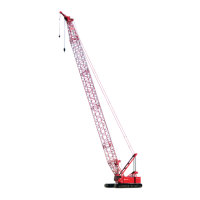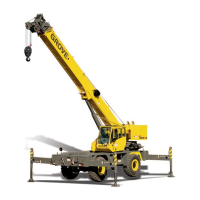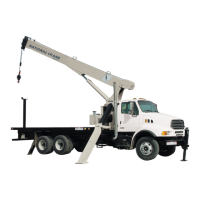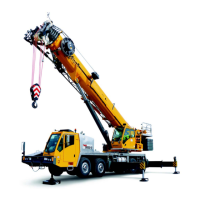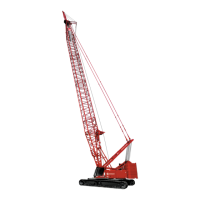Manitowoc Published 11-06-15, Control # 040-13 2-21
2250 SERVICE/MAINTENANCE MANUAL HYDRAULIC AND AIR SYSTEMS
Travel
1. Stop the engine.
2. Disconnect electric plug from travel brake solenoid valve
(Figure 2-25
). This will stall travel pumps.
3. Start and run the engine at 1,500 RPM.
4. Scroll to TRACK diagnostic screen. Monitor pump
pressure and command while moving control handles.
5. Slowly move both travel control handles in both
directions, one handle at a time.
6. Travel pressure for each crawler in both directions
should be 5,500 to 6,500 psi (379 to 448 bar) before
50% pump command is reached, and brake must not
slip.
7. If specified pressure is not indicated in either direction or
brake slips, determine cause and correct.
8. Connect electric plug to travel brake solenoid valve
(Figure 2-25
).
Load Drums
The following procedure must be performed after the crane
is fully assembled and rigged with boom.
1. Select FULL POWER mode at any load drum.
2. Scroll to corresponding DRUM (1, 2, or 3) diagnostic
screen. Monitor pump pressure and command while
moving control handle.
3. Working with a single-part line from first layer of selected
drum, hook onto a 40,000 lb. (18 144 kg) load.
4. Run the engine at 1,500 RPM.
5. Hoist load just clear of ground and fully apply
corresponding drum working brake.
6. Slowly pull corresponding drum control handle back.
Drum pressure should be 5,500 to 6,500 psi (379 to 448
bar) before 50% pump command is reached, and brake
must not slip.
7. If specified pressure is not indicated or brake slips,
determine cause and correct.
Auxiliary System Pressure Checks
The setup and jacking remote controls must be operated for
the following procedures. See Remote Controls topic in
Section 3 of Operator Manual for operating instructions.
Auxiliary System Relief Valve
1. Stop the engine.
2. Connect an accurate 0 – 6,000 psi (0 – 413 bar)
hydraulic pressure gauge to gauge coupler at auxiliary
system relief valve (Figure 2-26
, View A).
3. At main relief valve on auxiliary system control valve
(Figure 2-26
, View B), loosen lock nut and turn adjusting
screw in one full turn. Securely tighten lock nut.
4. Start and run engine at 1,500 RPM.
5. Fully retract both gantry cylinders until they bottom out
(stall hydraulic system). Gauge pressure should be
3,500 to 3,600 (241 to 248 bar).
6. If specified pressure is not indicated, proceed as follows:
a. Loosen lock nut on adjusting screw for auxiliary
system relief valve (Figure 2-26
, View A).
b. Turn adjusting screw in to increase or out to
decrease pressure.
c. Repeat step 5
through 6b until specified pressure is
obtained, and securely tighten lock nut.
7. Stop engine and remove gauge from coupler on auxiliary
system relief valve (Figure 2-26
, View A). Install
protective cap over coupler.
CAUTION
Overheating Damage!
It is necessary to stall hydraulic system during the
following pressure checks. Do not stall system longer
than necessary to read pressures and make adjustments,
or components may be damaged from overheating.
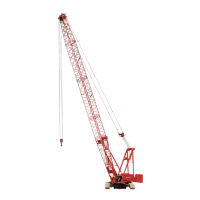
